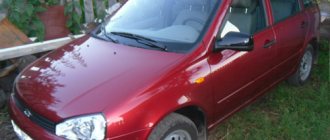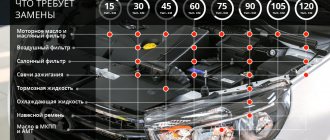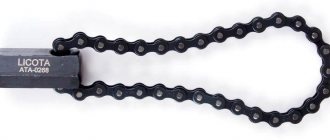For all Lada cars, the service interval is 15,000 km (the only exception is the Niva 4x4, which must undergo regular maintenance every 10,000 km), or once a year (whichever comes first). Many owners are familiar with the concept of “zero maintenance”, which, as a rule, involves replacing the engine oil and oil filter after the first 3,000 km. Let's figure out whether it is necessary to undergo TO-0 or not.
Until mid-2013, owners of Lada Granta and Lada Kalina cars had to undergo zero maintenance after 3,000 km. Later, the company changed the requirements, which it described in regulation No. 58-13.
Zero maintenance (2,000 – 3,000 km) must be carried out:
_x000D_
- _x000D_
- Lada Granta and Kalina (and now the budget Priora) with 8 valve engines (list of works - valve adjustment). _x000D_
- Niva 4x4 (list of works - changing transmission oil in the gearbox, rear and front axles, transfer case) _x000D_
_x000D_
It turns out that the first engine oil change on all Lada cars should be done at a mileage of 14,500..15,500 km (for Niva 4x4 in the interval of 9,500..10,500 km).
What kind of work does TO-1 Lada Vesta include?
Oil change First of all, the engine oil, oil filter and cabin heater filter are replaced. If necessary, add working fluids and change the front brake pads.
The cost of spare parts, working fluids and work on their replacement (refueling) is paid additionally.
TO-1 Lada Vesta and the list of works imply diagnostics of the following parts:
- suspension;
- steering;
- brake system;
- gearbox operation;
- operation of electrical equipment, including assessment of the condition of wiring (reliability of clamps and connections);
- integrity of hoses and pipelines, as well as their connections;
- fastening the chassis to the body;
- condition of disks, tires and their pressure;
- checking for extraneous noise and knocking in the engine, components and transmission;
- accumulator battery;
- body surface for cracks and corrosion;
- locks.
The service must eliminate any detected faults, and the car owner can receive recommendations for servicing the car. The maintenance regulations also provide for cleaning the drainage holes of thresholds and doors.
The rules require that upon completion of maintenance-1 a mark must be made in the service book.
Should I do it or not?
As I already wrote above, this process was mandatory on our cars, I remember driving my VAZ 2114 for sure! Although now on new VAZs (KALINA, GRANT, X-RAY, VESTA) there are the same intervals as on foreign cars, namely 10 - 15,000 km.
Technologies have stepped forward and now you don’t need to go to 1000 - 3000, or even 5000, and as I already said, an intermediate inspection is NOT mandatory. Manufacturers provide resources so that you can travel the first kilometers without any problems.
The main load falls on the oil filter; it contains chips that are formed from the break-in process. It is advisable to remove it from there or change the filter element itself. After all, if this is not done, then throughput drops
What problems are most often identified on Lada Vesta?
Corrosion of Lada Vesta parts After a run of 15,000 km, problems from this list are often identified:
- scratches on the glass (the warranty applies only if they appeared due to the operation of standard equipment);
- play in the lower ball joints;
- rubbing of the cooling system pipes;
- failure of the heated windshield;
- knocking of rear stabilizer struts;
- problems with the multimedia system;
- corrosion and burnout of the resonator body.
You may well demand that special attention be paid to checking for the presence of these problems or the prerequisites for their occurrence.
Timely maintenance and the use of high-quality consumables significantly reduce the risk of machine breakdown.
How much does it cost and can you do it yourself?
The cost will always be different, of course depending on the brand, model and class. But this is approximately 60 - 70% of the cost of the first maintenance. Personally, for my KIA OPTIMA it’s about 4,500 rubles, for example, for a new Solaris it seems to be about 3,000 - 3,500 rubles. But on AUDI, an “intermediate” one will cost about 12,000 rubles. NOT CHEAP!
However, many people ask the question - why don’t I do it myself, say, in my garage with my own hands? What a great idea, however, you need to choose exactly the right filter and oil (don’t be deceived). Otherwise, if the dealer notices, you risk voiding your warranty! Which is simply not acceptable for expensive cars. Therefore, it makes sense to overpay 1000 rubles. but go through the “officials”.
Now we are watching a short video on the topic
I’ll finish here, the information is useful, so we tell our friends and add it to our bookmarks. Sincerely yours, AUTOBLOGGER
What does TO-2 and subsequent maintenance include?
The next maintenance should be carried out every 15,000 km or a year after the previous maintenance - whichever comes first. Thus, TO-2 is 30,000 km or 2 years of driving, TO-3 is 45,000 km or 3 years of driving, etc.
The second maintenance of Lada Vesta, in addition to all routine maintenance of TO-1, includes the following procedures:
- replacing the air filter and spark plugs;
- lubrication of door hinges, rubbing areas of door opening limiters, hinges and springs of the fuel tank hatch, door keyholes and trunk lid;
- cleaning and lubricating battery terminals and clamps.
Taking this into account, the cost of a TO-2 Lada Vesta will be more than 7,000 rubles. But TO-3 repeats the work of the first one and its price will be corresponding.
Maintenance of Lada Vesta
The benefits are obvious to me personally
Firstly, no one is immune from manufacturing defects (even if it’s a cool foreign car, the human factor is always present), if it’s not a significant breakdown (as they say), then God bless it, but if it’s a serious breakdown of the chassis or engine, then it’s not very good anymore. You can detect this breakdown at an early stage.
Secondly, you will have all the vehicle's fluids checked. That is, it is possible to identify a problem with hidden defects, for example, the gasket between the “head” and the block itself is faulty, then the liquid will go either into the cylinders or into the manifold.
Thirdly, at “zero” - they will check your suspension camber, which affects tire wear and handling.
Fourthly, testing of all electrical sensors and wiring in general is carried out.
And the most important thing is to change the oil, for which you will need to pay, and for the oil filter too. But it still needs to be changed - SO I READ. I’ll explain why - a new engine is being run-in at the factory, however, with a run of 3000 - 5000 kilometers, many tiny particles of metal accumulate in it, which remain due to the lack of wear of the metal in the cylinders. And the lubricant that is poured accumulates these particles.
They are not useful at all, and are even very destructive! With a mileage of 3000 - 5000 km, the running-in mode is completely completed and all the “metal dust” is in the oil. You can, of course, wait for the first maintenance, which will occur at 10,000 - 15,000, but it is better to remove this “dust” earlier, just at the “zero maintenance”, at 5000 – 7500 km. This will allow your engine to last as long as possible, of course if you expect to drive this car for a long time.
What is “zero maintenance”
Zero maintenance is a type of maintenance that is carried out after 2500-3000 km. For some cars of the Lada TO-0 line, this is a mandatory measure, but Vesta is not included in their list. However, for her such a check would be quite appropriate.
TO-0 Lada Vesta usually includes:
- changing oil and filter;
- checking for extraneous noises and sounds;
- checking the smoothness of gear shifting;
- checking wheel alignment angles;
- checking the main systems;
- checking the operation of the headlights and adjusting them (if necessary).
Reviews
Owners of Lada Vesta often mention on various forums about maintenance, its shortcomings, and frequent breakdowns.
Ivan Semyonov writes: “It is better to personally observe what exactly the masters do. At the first service, someone only changes the oil and filter, while at another dealership they additionally carry out all the necessary diagnostics and inspect the car on a lift. Vesta has not yet proven its reliability in comparison with the same Hyundai Solaris and Kia Rio. Let’s see what kind of maintenance will be needed after a mileage of 150 thousand km.”
Evgeniy left a similar review: “A lot depends on the dealer, in some places they will change the oil and say “goodbye,” and in others they will lubricate everything, check the suspension, brake system, and even wipe it where necessary. However, the difference in cost may be minimal. But prices are relevant only during the warranty period; after its expiration, maintenance can increase significantly.”
How to use the diagnostic connector
- Directly to destination. To diagnose a car using an adapter that is connected to a computer or phone, or to a special diagnostic device.
- For the purpose of having fun. Connect the adapter and install the Torque program on your phone, connect to it using a Bluetooth connection, and you can view the data online. And if you have a phone with GPS, then you can measure acceleration to 100 km/h, time to cover a section, etc.
Diagnostic connector with connected adapter ELM327
To carry out diagnostics and connect to the “masses” of a car with an injector, you need to know where the OBD2 diagnostic connector is located. Also, to select a scanner for diagnostics, you should know the pinout of not only the OBDII output, but also the ECU (electronic control unit).
VAZ engineers, when developing the Lada Granta, provided for a not very convenient location of the diagnostic block, placing it on the right side of the central column, on the passenger side.
The connector is not covered with a cover, but is half hidden by the interior plastic lining of the cabin. The adapter must be inserted from the bottom up, which also makes access and orientation of the connectors difficult. Connector type - OBD2 16 pin.
Connector lock
Hijackers can be confused by other methods. Here are some examples of how to block access to the Vesta diagnostic connector:
- Change the input from 16 pins to a different number. However, this will complicate further diagnostics of the car.
- Remove the Vesta diagnostic connector to a secret place. But this may be a reason to remove the car from warranty.
- Install a blocking relay between the connector and the control unit. How to connect the diagnostic connector? If you do it yourself, you may accidentally short the wires. Therefore, it is better to turn to the experts.
This modernization complicates many issues. The question arises: might it be easier to park your car under security and not create complications?
Methods for diagnosing ECUs and errors on Lada Vesta via OBD2
Let's look at examples of analyzing machine systems in different ways.
Check Engine light on Vesta?
Detailed article on the causes of Check Engine and how to clear the Check. If your Check Engine light comes on, read this article immediately. The material explains what a Check Engine is, what to do if it appears, and how to remove this error yourself.
Is the Check Engine light on?
TOP 15 reasons why the Check Engine light comes on and ways to solve the problem. Read the article to solve the Check Engine problem.
To enter the BC diagnostic mode, hold down the top key and turn on the ignition.
Reviews of diagnostic scanners for LADA VESTA
Read detailed articles on the review of car scanners, including those compatible with LADA VESTA.
Reviews of OBD2 diagnostic car scanners
This section provides descriptions of diagnostic scanners and adapters. Before purchasing a scanner for your car, it is recommended that you read reviews of the most popular equipment models.
New software is written using programmers. There are open and closed ECUs.
- In a diagnostic way. Without removing the ECU from the vehicle via the diagnostic connector using flash loaders and a program such as Combiloader.
- Work via BSL mode of the ECU processor. With this method, programming the ECU is carried out by removing the latter from the car using bootloaders that work with the ECU processor via BSL mode.
↑ Filling volumes
The amount of consumable fluids to be replaced depends on the type of engine, gearbox, cooling and heating system.
For motor 11189 (volume in l):
- the need for a lubrication system with a stamped sump is 3.2;
- with a cast crankcase - 4.4;
- for gearboxes 2180 and 2182 – 2.25;
- JHQ – 3.34;
- cooling and heating system requirement – 5.95;
- for a system with preheating – 9.3;
- for the hydraulic drive and brake system – 0.559;
- for the washer reservoir – 4.7;
- expansion tank - 5.75;
- air conditioner - 0.475.
For engine 21129, the difference in volumes lies in the following parameters:
- for a fuel system with a stamped crankcase - 2.9 l;
- with cast – 4.1 l;
- for expansion tank - 5.35 l.
HR16DE engine: lubrication system requires 4 liters; for cooling and heating – 7 l.
Recommended brands of engine oil are Maximum SW-40, MOBIL 3000 SW40, LADA ULTRA 5W-40.
Important! When replacing, mixing different brands of oil, coolant, brake fluid and refrigerant is not allowed.
approximate cost
It is impossible to name the exact cost of maintenance, since everything depends on the specific situation and the list of work performed, in addition to the regulated ones. And they will definitely be there.
According to the official AvtoVAZ website, the approximate prices are as follows:
- For TO-0 1600 rubles for an 8-valve internal combustion engine. Other versions of TO-0 do not pass;
- TO-1 will cost 5-6.5 thousand rubles;
- TO-2 costs about 6-7.2 thousand rubles;
- TO-3 from 5 to 6.5 thousand rubles;
- TO-4 from 6 to 7.3 thousand;
- TO-5 about 5-6.5 thousand;
- TO-6 will cost 11.5-12.5 thousand rubles.
The exact cost can be found out after the diagnosis. The craftsmen will draw up a list of necessary work.
Compared to many other cars, maintenance for the Lada Granta is cheap. But even for such a car you have to pay money if the owner is interested in maintaining its technical condition at the proper level.
Source
Body
In most cases, Lada Vesta owners have no complaints about the quality of the paintwork, much less the protection of body elements from corrosion. But some of its parts may still not withstand the influence of the external environment, namely:
- Roof, because it has the least protection against rust.
- Front bumper paint that is chipped off by gravel. Fortunately, this element is made of plastic and is not subject to corrosion, but its peeling appearance clearly does not decorate it. The rear bumper coating at the points of contact with the trunk lid also wears out quickly.
Problems with high mileage of a car Rust may appear on metal parts in the engine compartment, because... Due to the loose fit of the hood lid, a lot of dirt and moisture gets there.
Breakdowns
When cold, the gearbox rattled noticeably in neutral. Shifting from 3rd to 2nd gear required effort. The right drive oil seal fogged up. We decided to change the transmission oil, after which the noise changed its tone and began to appear in other temperature conditions, and switching to 2nd gear became a little easier. Cause: The release bearing has fallen apart.
. The probable cause is a manufacturing defect.
Second gear synchronizer rings burned out
. In a cable-driven gearbox, they do not burn out due to sporty driving or while reversing. Insider information from the factory confirmed this version (the second/third gear clutch is engaged when reverse gear is engaged). To solve this problem, the factory installs a foreign-made plug.
If you slightly tighten the drain plug of the cable transmission, the gearbox housing begins to crack
. It is dangerous to turn this plug without a torque wrench. Since 2015, AVTOVAZ has modernized the design; now additional small stiffening ribs and one massive one in the form of a rim have been made on the body in the place of the oil drain hole.
At 45,000 km, the intake pipe became snotty.
The oil was squeezed out through the joints of the channels near the spark plug wells. Apparently, this is a consequence of prolonged operation of the engine at high speeds. Instead of expensive soldering of problem joints, I used sealant. After 2000 km everything is dry - the problem is gone.
Weak fastening of the steering cardan
. For some reason, its play is heard as a knock in the steering rack, even when you check the connection by touch by shaking the steering wheel.
ECU protection
The Lada Vesta car has an alarm system and central locking. However, car thieves continue to steal it. They break into the hood lock of the Vesta and replace the electronic unit with their own, which operates from a third-party immobilizer.
After protection, removing the ECU is not so easy. There are manufacturers in Russia who offer to install protection for such units. In addition, it can be ordered individually from craftsmen.
The Lada Vesta ECU protection is made in the form of a metal protective box made of 3 mm thick steel. The block is located in this container and is fixed to the car body using studs equipped with shear nuts. If the thief decides to pull out the block, then he must cut the steel cover. Therefore, hijackers will not do this.
A disadvantage of the electronic unit protection design is the risk of the pins breaking off when installing it yourself. After this, you will have to contact a car service to repair the unit.
Muscovites, attention!
Editorial Vesta was purchased from the Tekhinkom dealer in Strogino. There we also passed the first maintenance at 15,000 km. There were no complaints about the service, but it was too far away. It was inconvenient to get to home or work without leaving the car. Therefore, in the interval from 15,000 to 45,000 km, I went to VDNKh for maintenance and elimination of a number of problems under warranty.
It would be a good idea to consult the manufacturer’s official website before each trip to the service. I was close to undergoing maintenance on a car under warranty at a service center that had been deprived of its official status just a couple of weeks before the visit. Autocomplex continues to call itself an “official dealer,” but the lada.ru website does not know about it.
It would be a good idea to consult the manufacturer’s official website before each trip to the service. I was close to undergoing maintenance on a car under warranty at a service center that had been deprived of its official status just a couple of weeks before the visit. Autocomplex continues to call itself an “official dealer,” but the lada.ru website does not know about it.
I signed up there for the 45,000 km TO, but when I entered the territory I was embarrassed. The parking lot is practically empty, which has never happened before, the showroom is also empty, and the “Lada” inscription has disappeared from the facade. The AVTOVAZ website confirmed the suspicions: Avtokompleks was excluded from the list of official dealers, although the service center continues to call itself that on the website. And during the recording, the girl operator modestly kept silent about this nuance. Really, it's not good!
The outside temperature sensor on Vesta is poorly located. Once you get stuck in a traffic jam with the air conditioning on, you find yourself in a natural bathhouse. The picture was taken a minute before, at real +30 on the street, +51 will appear on Vesta’s display. With the start of production of station wagons on all Vestas, the location of its attachment has been changed.
The outside temperature sensor on Vesta is poorly located. Once you get stuck in a traffic jam with the air conditioning on, you find yourself in a natural bathhouse. The picture was taken a minute before, at real +30 on the street, +51 will appear on Vesta’s display. With the start of production of station wagons on all Vestas, the location of its attachment has been changed.
The service had to be rescheduled. Thus, our Vesta underwent all three maintenance in different services. I was lucky: a suitable center was found at the same distance from home as the previous one. But things could have turned out to be much more complicated. In Moscow, Lada has 13 dealers left, and 10 of them are located on the Moscow Ring Road, which is not always convenient from the point of view of transport accessibility. The remaining three are also far from the center, halfway from the Moscow Ring Road to the Third Ring Road.
One day I noticed in the mirror that the gas tank flap opened on left turns. Inspection showed that the black bar on the hinge was missing (there is in the photo of the white car and is missing in the photo of our Vesta), which is responsible for pressing the sash. The part is supplied separately, but for its size about the phalanx of the little finger it costs a lot - 290 rubles.One day I noticed in the mirror that the gas tank flap opened on left turns. Inspection showed that the black bar on the hinge was missing (there is in the photo of the white car and is missing in the photo of our Vesta), which is responsible for pressing the sash. The part is supplied separately, but for its size about the phalanx of the little finger it costs a lot - 290 rubles.
Children's engine sores
Lada Vesta is a Russian car, people usually listen to it and sniff it.
DETAILS: Common faults on the VAZ 2110 2111 2112 Main weaknesses and frequent breakdowns of Ladas of the tenth family in infographics
Many car enthusiasts are alarmed by the sound of the engine
Which migrated to the Lada Vesta from the Lada Kalina, Lada Granta and Priora. This 16 valve engine with a capacity of 106 horsepower was installed on many AvtoVAZ models. For the Lada Vesta, a similar engine is available in a modernized form. It does not have a large list of significant alterations, although it is worth noting that it is adapted to Euro 5 standards.
The engine, due to its environmental friendliness, has become sensitive to fuel quality. You should not experiment with questionable fuel as there have been precedents when problems with valves arose. Disassembly of the engine shows that low-quality fuel simply cannot be digested, which causes big problems with valve sticking and scuffing.
— there are more and more complaints about unstable idling;
— revolutions float;
Where is the LADA VESTA ECU located?
The ECU on the Vesta is located in the engine compartment (engine compartment). The control housing is rigidly fixed to the vehicle frame. The wiring harness approaches the device from below and is connected through a block with latches. Due to its location under the hood, the VESTA ECU can become a target for thieves who replace the device with another. The method of protecting the unit from intruders is an additional housing made of 3 mm steel with stud fastening to the frame.
Photo source: https://www.drive2.ru/l/551817399263822806/
Diagnostics and error reset are carried out through this device using ELM327. The control unit is removed in order to flash new software using a bootloader in BLS mode.
Self-service
Since the three-year warranty period had ended, we saw no reason to overpay the dealer for work if we had our own technical center in Tushino. And the consumables purchased at a regular spare parts store made the pockets lighter to a minimum. A canister of “synthetics” Lada Ultra 5W40 (1187 rubles), oil (193 rubles), air (255 rubles) and carbon cabin filters (334 rubles) - that’s the entire set required. Total - less than 2000 rubles for everything. An official TO-5 dealer would cost about 7,000 rubles.
May and early June in Moscow turned out to be unusually hot. Now is the time to check your air conditioner. It hasn’t lost any of its strength; it cools the interior, just like three years ago—almost instantly. We haven’t cleaned the radiators on Vesta yet. And judging by the antifreeze temperature arrow, this is not yet required. The editorial machine has an instrument cluster with old firmware, in which the needle tries to show the real temperature, and not the average 90 degrees. So: it doesn’t fall beyond the usual limit (by eye - about 95–97 degrees) in traffic jams.











